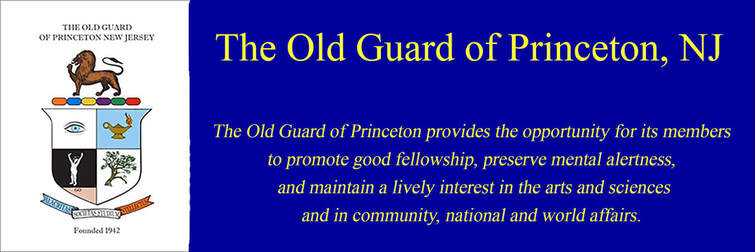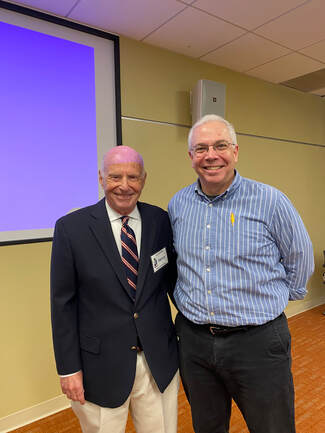November 1, 2023
The End of the Post-Network Era? American Television Today
William Gleason
Hughes-Rogers Professor of English and American Studies, Princeton University
The End of the Post-Network Era? American Television Today
William Gleason
Hughes-Rogers Professor of English and American Studies, Princeton University
Minutes of the Ninth Meeting of the 82nd Year
President John Cotton called the meeting to order at 10:15 AM on November 1, 2023, and Julia Coale led the membership in the invocation. There were 125 members in attendance. Keith Wheelock read the minutes of the prior meeting.
President Cotton reminded the membership that they should keep the microphone up by their chin when speaking to the membership. He also advised that updated thumb drives were available as well as detailed information sheets regarding the Old Guard. Rosters were to come later in the week via email.
President Cotton introduced the meeting guests: Anita Brady, who wishes to apply for membership and is the guest of Steve Silverman; Meredith Von Kohorn, guest of Henry Von Kohorn; Natalie Skvir, guest of Tass Skvir.
President Cotton announced that Frankenstein, the opera, whose composer and producer spoke to the Old Guard last year, had premiered in the Arizona Opera house to critical acclaim.
President Cotton asked for a moment of silence in memory of member Larry Parsons who died on October 18, 2023.
Henry Von Kohorn introduced the speaker, William Gleason, the Williams-Rogers Professor of English and American Studies at Princeton University. Professor Gleason, a former chair of the English Department, teaches courses on American literary history, popular literature, place and environment, and sport and society. He is well known for teaching a highly popular course on the subject of children’s literature. Last semester, he filled McCosh 50 with the department’s first-ever course about American television, the subject of his address to the Old Guard.
Professor Gleason stated that he had divided his topic into four segments: The Princeton Course, The Evolution of American TV, The Post-Network Era and What Now/What Next.
The Princeton Course was the first lecture course on American TV intended to complement the course given on American cinema. American TV was a broader topic of study for undergraduates. There were the delights and demands of serial and episodic storytelling, the structure of seasons and series and the role of TV in shaping ideas about reinforcing or destabilizing issues, such as race, gender, and sexuality. TV was considered as an English project as it is not only an art form, but a business and a form of storytelling.
Describing the Evolution of TV, Professor Gleason stated that the first golden age was from 1947 to the late 1950s. Many beloved programs were aired such as I Love Lucy or Leave it to Beaver. During this period, 50% of the population had TVs and 60% were tuned to the same program, as there were only a handful of channels and programs to watch.
After the golden age, the network era began from the late 1950s to the mid 1980s, dominated by ABC, CBS, and NBC. Most programs had been broadcast live but were now being taped or filmed, and advertising was prolific. The culmination of industry reruns and syndication, when episodes were rented or sold to other channels, made the industry flush with cash. However, eventually the network era began to evolve as cable, and satellite TV came into being, which had a destabilizing effect. Writers, producers and actors were still making money out of residuals but there were more markets available to sell shows.
The post network era began around 2000. There were even more channels and streaming services, which broadened the options for watching and narrowed some of the audiences for channels. Usage of DVRs allowed viewers to record episodes or entire series and watch them when they wished. Subscriptions such as Netflix or Amazon Prime further severed the monopoly of TV channels. This was the second golden age, a new era of outstanding programming, with expensively produced award winning TV shows. Streaming brought in more capital and more shows and drew people from film to TV. In 2022 there were 600 scripted TV shows on air. This was peak TV quality programming and accessibility. Watch whatever you want wherever you want from your pocket with your mobile device!
Netflix was the author of this promise and although it did not begin as a network it became one. There was less focus on advertising and less interest in syndication, as money was made selling subscriptions not shows. Eventually new streaming services came into being and began to pull their shows off Netflix and Amazon Prime. As a result, in 2022, although Netflix was the only substantially profitable streamer, it lost subscribers for the first time; the bubble had burst. Wall Street took note and stated that profits were essential. This heralded the new era of TV which began to look like the old network era.
In late 2022 streaming began cancelling shows. Those shows could be rented or licensed to another provider, thus making money. In addition, if a show was not sold it could be depreciated and become a tax write off, thus increasing Wall Street profits. Streaming channels could combine or collapse but there would be fewer prestige shows, as more ads and higher fees improve profits. Although streaming appeared to be broken it was not going away; in 2022 Americans watched 15 million years of streaming TV! The old network era relying on ads and syndication control and fewer channels is back!
Finally, Professor Gleason spoke of the writers’ strike and stated that the result was more spending on everything, better pay to possibly include pay based on how many viewers watch a show, safeguards for AI, and new guarantees as to how long one may be employed on a show.
In response to questions, Professor Gleason stated that PBS had played a small role in shaping the development of TV due to its modest funding but that globalization was essential to the streaming model allowing subscriptions from across the world.
Respectfully submitted,
Dulcie Bull
President John Cotton called the meeting to order at 10:15 AM on November 1, 2023, and Julia Coale led the membership in the invocation. There were 125 members in attendance. Keith Wheelock read the minutes of the prior meeting.
President Cotton reminded the membership that they should keep the microphone up by their chin when speaking to the membership. He also advised that updated thumb drives were available as well as detailed information sheets regarding the Old Guard. Rosters were to come later in the week via email.
President Cotton introduced the meeting guests: Anita Brady, who wishes to apply for membership and is the guest of Steve Silverman; Meredith Von Kohorn, guest of Henry Von Kohorn; Natalie Skvir, guest of Tass Skvir.
President Cotton announced that Frankenstein, the opera, whose composer and producer spoke to the Old Guard last year, had premiered in the Arizona Opera house to critical acclaim.
President Cotton asked for a moment of silence in memory of member Larry Parsons who died on October 18, 2023.
Henry Von Kohorn introduced the speaker, William Gleason, the Williams-Rogers Professor of English and American Studies at Princeton University. Professor Gleason, a former chair of the English Department, teaches courses on American literary history, popular literature, place and environment, and sport and society. He is well known for teaching a highly popular course on the subject of children’s literature. Last semester, he filled McCosh 50 with the department’s first-ever course about American television, the subject of his address to the Old Guard.
Professor Gleason stated that he had divided his topic into four segments: The Princeton Course, The Evolution of American TV, The Post-Network Era and What Now/What Next.
The Princeton Course was the first lecture course on American TV intended to complement the course given on American cinema. American TV was a broader topic of study for undergraduates. There were the delights and demands of serial and episodic storytelling, the structure of seasons and series and the role of TV in shaping ideas about reinforcing or destabilizing issues, such as race, gender, and sexuality. TV was considered as an English project as it is not only an art form, but a business and a form of storytelling.
Describing the Evolution of TV, Professor Gleason stated that the first golden age was from 1947 to the late 1950s. Many beloved programs were aired such as I Love Lucy or Leave it to Beaver. During this period, 50% of the population had TVs and 60% were tuned to the same program, as there were only a handful of channels and programs to watch.
After the golden age, the network era began from the late 1950s to the mid 1980s, dominated by ABC, CBS, and NBC. Most programs had been broadcast live but were now being taped or filmed, and advertising was prolific. The culmination of industry reruns and syndication, when episodes were rented or sold to other channels, made the industry flush with cash. However, eventually the network era began to evolve as cable, and satellite TV came into being, which had a destabilizing effect. Writers, producers and actors were still making money out of residuals but there were more markets available to sell shows.
The post network era began around 2000. There were even more channels and streaming services, which broadened the options for watching and narrowed some of the audiences for channels. Usage of DVRs allowed viewers to record episodes or entire series and watch them when they wished. Subscriptions such as Netflix or Amazon Prime further severed the monopoly of TV channels. This was the second golden age, a new era of outstanding programming, with expensively produced award winning TV shows. Streaming brought in more capital and more shows and drew people from film to TV. In 2022 there were 600 scripted TV shows on air. This was peak TV quality programming and accessibility. Watch whatever you want wherever you want from your pocket with your mobile device!
Netflix was the author of this promise and although it did not begin as a network it became one. There was less focus on advertising and less interest in syndication, as money was made selling subscriptions not shows. Eventually new streaming services came into being and began to pull their shows off Netflix and Amazon Prime. As a result, in 2022, although Netflix was the only substantially profitable streamer, it lost subscribers for the first time; the bubble had burst. Wall Street took note and stated that profits were essential. This heralded the new era of TV which began to look like the old network era.
In late 2022 streaming began cancelling shows. Those shows could be rented or licensed to another provider, thus making money. In addition, if a show was not sold it could be depreciated and become a tax write off, thus increasing Wall Street profits. Streaming channels could combine or collapse but there would be fewer prestige shows, as more ads and higher fees improve profits. Although streaming appeared to be broken it was not going away; in 2022 Americans watched 15 million years of streaming TV! The old network era relying on ads and syndication control and fewer channels is back!
Finally, Professor Gleason spoke of the writers’ strike and stated that the result was more spending on everything, better pay to possibly include pay based on how many viewers watch a show, safeguards for AI, and new guarantees as to how long one may be employed on a show.
In response to questions, Professor Gleason stated that PBS had played a small role in shaping the development of TV due to its modest funding but that globalization was essential to the streaming model allowing subscriptions from across the world.
Respectfully submitted,
Dulcie Bull

